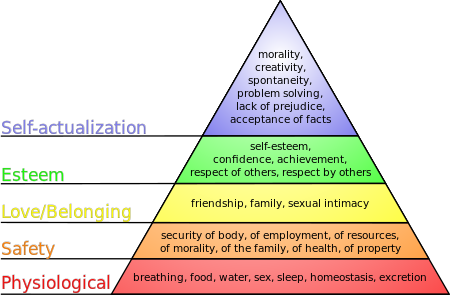Maslow defines a hierarchy, a metaphorical stepladder if you will, which depict the order in which the needs of an individual must be met. He claims that one's motivation for satisfying needs starts at the bottom and in order to move up to the next level, the current level's needs must be met.
"Physiological needs are the most pre-potent of all needs," or in other words, we need food and other basic necessities before we begin to worry about other parts. The next levels, in order, are:
- safety and stability,
- love (both giving and receiving),
- esteem (which includes "importance" and "reputation", but also "independence and freedom"), and
- self-actualization ("doing what he is fitted for")
Here's an easy image to help visual-learner's understand:
I had always heard this theory referenced, but I had never looked up the paper or thought about it in the context of revolution. It can help predict the focus of revolt's based on the lowest-order needs not being accommodated to a group of people and it can help policy-maker's define basic human rights. Maslow's writing can help us understand people's motivations for revolution, especially the differences between revolutions in the developed, developing, and undeveloped worlds. One can see that those without sustainable access to water are not worried about being free but that politically stable countries containing people with high self-esteem will focus on creative problems, revolutions in technology, and other problems further up the hierarchy.

Ah, the good ol' Maslow's Hierarchy of Needs.
ReplyDeleteI've always found the hierarchy to be particularly interesting, as it screams of excessive limitation and something that is bound to be appended with hundreds of "exceptions" to the rule. Is the prioritization of safety really a stepping stone to friendship and family? Does being truly "hungry" always diminish feelings of self-esteem and respect from others? Having been introduced to Maslow in high school psychology, I've always viewed the hierarchy as something that is well meaning, albeit a bit of a stretch in practical application.
From my additional reading this week, including Maslow's paper which you linked above, something that comes to attention is the rigid, geometric structure usually presented in figures of the hierarchy despite Maslow's paper stressing that the events are not in a "step wise, all or non relationship". While the needs are certainly organized categorically, Maslow himself did not create the pyramid, and I was interested to learn that the pyramid structure was actually not even in his original book. Without the rigidity of structure, Maslow's theories make a bit more sense to me, as freedom to move within the needs becomes a more individualized process, rather than a set of stairs.
Regarding the idea of Maslow in relation to revolution, I caution the universal application of the hierarchy to revolutions, as in reading the original 1943 paper it was clear that this is focused on the individual, not the group. I find the distinction rather important in understanding social behavior, as analyzing a group as a group structure instead of a group of individuals can lead to vastly different conclusions.
I'm glad you pointed this out Bradley. There's a strong difference between the pyramid/hierarchy and Maslow's original work. This is why it's so important to read a great thinker's own writing. Such expansive ideas become codified/restricted by others until the next great thinker comes along and blows them open again. For example, this has happened with Freud's work several times over.
ReplyDeleteI find this structure very intriguing. Marlow's adapted triangle (though, granted, not his original work) implies that stepping stones must be placed in order to reach the next step. This implies that you cannot have self-esteem without love or problem solving without sex or friendship without the safety of employment. I tend to believe that in today's age, these ideas do not correlate as strongly. Aren't we suppose to lean on friends when we don't feel safe? Will I solve tough social issues without sex? Can we live independently without the need of our basic 'tribal' needs?
ReplyDeleteFurthermore, reading "Einstein's Dreams" has forced me to reconsider how I view linear progression. How will we appreciate the importance of each step if we do not find out its meaning? Now I am not saying that we need to have sexual intimacy before we learn the importance of excretion, but I see how a few steps can be skipped. If someone knows the importance of self-esteem then their interpersonal relationships are bound to be stronger. If they cannot believe in themselves and instead lean on others first they may never see the importance of independent confidence. I will admit that I did not read the original Marlow post, but I can see why he didn't propose this. If we assume that the human experience is a linear progression, we miss out on the beauty of being a person. The levels make each previous notion stronger, but sometimes it is necessary to start a little higher.
I think it is interesting how many things in this pyramid seem to overlap. For example we physiologically need sex to reproduce, but for Love/Belonging we need sexual intimacy. Physiologically we need water and food and sleep and so forth, but under safety health is listed. I think it is strange that sex and sexual intimacy is separated, just as heath and physiological needs is separated. To me it represents the school of thought that humans are first animals, and second beings of higher intelligence. Our physiological needs are met because we are organisms who cannot survive without such necessities, but yet we as intellectual creatures cannot survive without other so-called necessities.
ReplyDelete